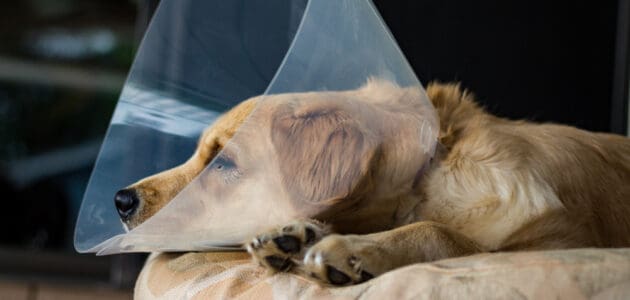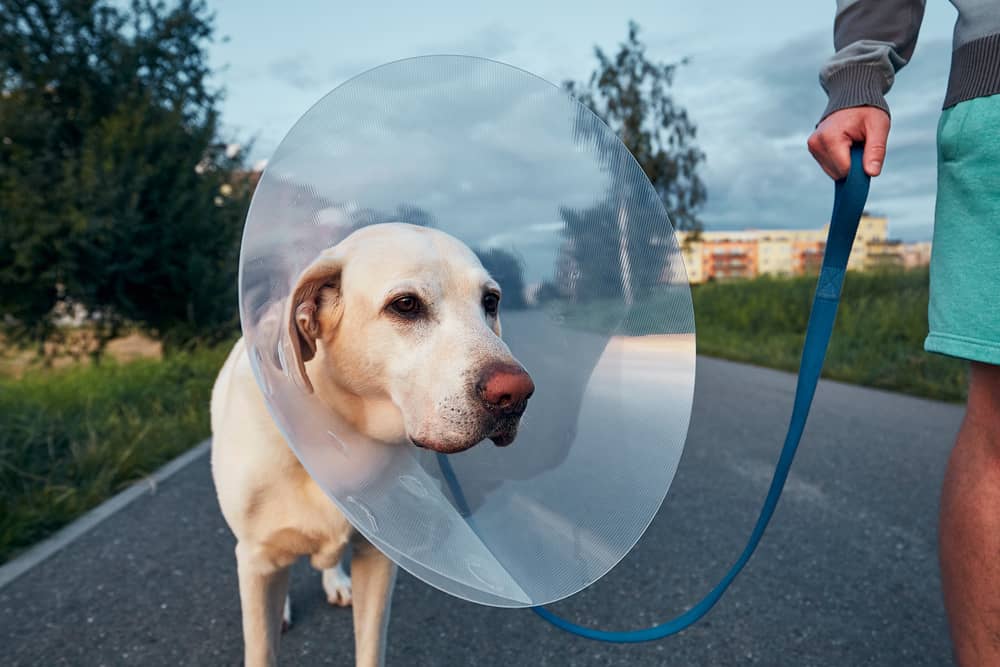How Soon Can I Walk My Dog After Neutering?

Neutering or spaying your dog is generally considered the responsible thing to do, but that doesn’t mean it comes without complications and important considerations. After all, it may be the most common surgery that vets do, but it’s still a surgical procedure that means your best friend will be down for the count for at least a few days.
How soon after your dog is neutered or spayed can you take them for a walk? While there’s no single answer to that, it’s best to plan for keeping your dog largely inactive for at least a couple of weeks. Your vet’s advice is best, but read on to learn more about what factors may affect your dog’s surgical recovery. We’ll also take a close look at the benefits of neutering, how the surgery works, and what you can expect as your dog recovers.
When Can You Walk Your Dog After Neutering?
You should plan for your dog to require restricted activities for at least one week, though your vet may recommend activity restriction for up to 14 days. While you should take your dog out on a leash during that period, a long walk is not recommended.
However, once the surgical site is healed, which generally is between 10 and 14 days, you can begin to slowly resume your normal activities, including going for walks. It’s best to resume activities gradually to avoid muscle strain or injury and so that you can monitor your dog for any further surgical complications.
To be certain you’re not pushing your dog too hard, check out our tips on a healthy recover below.
Why Neuter Your Dog?
Neutering (which is done to male dogs) and spaying (which is done to female dogs) change the physiology of an animal to make it impossible for them to reproduce. While not all pet owners choose to do this, these procedures are recommended to help fight the stray population. In fact, for about 30 years, longtime “Price Is Right” host Bob Barker encouraged viewers to “help control the pet population — have your pets spayed or neutered.”
Spaying and neutering, in addition to reducing the population of stray cats and dogs, can have other benefits for individual animals — and the people they live with. Here’s a look at the biggest benefits of neutering your dog.
Longer Lifespan
One study found that neutered dogs lived about 14% longer and spayed dogs lived more than 26% longer than their unaltered counterparts. It’s believed that behavioral changes that can make dogs less likely to dart away from the house, as well as reductions in risks for certain cancers, can be credited for lengthened lifespans of neutered dogs.
Behavioral Improvements
Neutered dogs are less likely to feel a strong desire to “mark their territory,” which is certainly an unwanted practice inside your home, and even female dogs are known to engage in urine marking. Other problem behaviors that can be improved, though not always removed entirely, include escaping and roaming, constant barking, and mounting activity.
No Surprise Puppies
Though this is more of a benefit for the owners of female dogs, if you get your male dog neutered, you can rest assured he won’t sire any litters of unplanned-but-adorable puppies.
Having your dog neutered at your veterinarian’s office is typically quite affordable, and the average vet performs more neuters and spays than any other type of procedure.
For dog owners who can’t afford the up to $300 on average to have your vet neuter your dog, there are many low-cost or even free clinics that offer to perform these procedures to help reduce the population of stray animals. Unsure if there’s one in your area? Check out this ASPCA page, or call your local animal shelter, as many offer free or low-cost clinics as well.
Common Neutering Questions
To help you be prepared for your pet’s surgery, we’ll answer some of the most common questions about this procedure.
Is Neutering Dangerous?
Both spaying and neutering are considered surgeries, so they carry inherent risk, as your dog will be under general anesthesia for the duration of the procedure.
How Does Neutering Sterilize a Dog?
When a female dog is spayed, her reproductive organs are removed, which generally includes her ovaries, fallopian tubes, and uterus. For a male dog, the testicles and related structures are removed.
One reason for completely removing the reproductive structures is to fully sterilize the dog. For humans, it’s more common for a woman to have her tubes tied or for a man to get a vasectomy to permanently prevent pregnancy. But in both cases, there is a small failure rate, and it’s technically possible for a pregnancy to occur even after one of those procedures.
With dogs, neutering and spaying are designed to make reproduction physically impossible.
Are There Non-Surgical Alternatives for Neutering a Dog?
There are non-surgical options for neutering a dog, including injections, contraceptive implants, and oral medications, but surgery is considered the standard.
At What Age Should You Neuter a Dog?
The best age to spay or neuter a dog is the subject of some controversy, though it’s generally possible to do so with a puppy starting around 4 months, and adult dogs can be spayed or neutered as well. The reason for controversy is that it had long been standard practice to spay a female dog before she reaches her first heat cycle, but more recent study has suggested that it’s best to wait until after a dog reaches sexual maturity.
Because there’s far from consensus on the best approach, you should consult with your dog’s veterinarian for their guidance, and all the available research would seem to indicate that there are few if any medical reasons to rush this procedure and that the benefits are largely behavioral.
Are There Any Reasons to Have My Dog Neutered Sooner?
The breed and your family’s specific situation may dictate the best course of action.
For example, larger breeds of dogs tend to mature more slowly than smaller dogs. Experts generally recommend waiting to neuter or spay large breeds until puppy growth has stopped and they’ve reached their full adult size, which is anywhere from 12 to 15 months.
On the other hand, if you have a reason to be concerned that your female puppy will have any chance of unintended pregnancy (for example, if you’ve adopted a brother-sister pair of littermates), both probably should be spayed and neutered sooner rather than later if you won’t be able to ensure you can keep them apart.
Will Neutering a Dog Change How They React to Dogs in Heat?
Remember that dogs can become difficult to deal with during females’ heat cycles, which occur about twice a year in unaltered female dogs. When they’re in heat, female dogs experience hormonal changes that can make them edgy or aggressive; and they give off pheromones that attract male dogs, who may then become aggressive and prone to fighting. Neutering a male dog will most likely reduce the chances of this behavior, but if may not eliminate it entirely.

What to Expect After Your Dog’s Surgery
Spaying and neutering are the most common surgical procedures for the average veterinary clinic, so the risk of complications is low for most dogs. That said, it is a surgery, and all surgical procedures carry some risk. However, your vet or neutering clinic will examine your dog before the surgery and may conduct bloodwork to ensure they are healthy enough to undergo the procedure.
Here’s a look at what you can expect from the time your dog goes under the knife:
The Surgery
Neutering is usually a shorter procedure than spaying, as it is somewhat less invasive; the testicles are removed by making a small incision in the scrotum, which is then closed with dissolving stitches. The process usually takes about five to 20 minutes, depending on the dog’s size and age.
Spaying is a bit more complex. In most procedures, the vet makes an incision in the middle of the dog’s abdomen to remove her reproductive organs, typically fallopian tubes, ovaries, and uterus. As with male dogs, the incision is closed with dissolving stitches. The entire surgery usually last at least 20 minutes and can take as long as 90 minutes, depending on age and size, as well as if the dog is currently in heat.
Heading Home
Many but not all dogs are able to go home the same day they have their surgery. The biggest reason for keeping them overnight is to ensure there’s no internal bleeding. Additionally, this helps the vet make sure your dog’s activities are limited, which is helpful when incisions are fresh. However, many vets prefer to send dogs home, as being in familiar surroundings is more comforting.
Whether it’s the same day or the morning after you dropped your dog off, they will probably still be quite tired and groggy when you arrive. Don’t worry if their response to seeing you again is subdued. You should plan to remain with your pet at least overnight, and if you must leave the house, it’s best to have someone come over to monitor your pet.
After-Care Needs
You don’t need to remain next to your dog forever, and the first night or two after surgery are generally the most important. In those first couple of days, if you notice concerning signs like vomiting or lethargy, these could be indications of internal bleeding, and you need to call the vet right away. Excessive bleeding and discharge around the incision also are signs that something is wrong.
You should check your dog regularly for these signs and be sure to follow all after-care instructions from your vet. After the first couple of nights, the most important things are to keep the incision clean and prevent your dog from being able to lick or scratch at their stitches. Surgical recovery cones are helpful for this, and when you’re not able to be near your dog, they should be in a crate or kennel that can restrict their movement.
Some vets will send you home with pain medication to help alleviate your dog’s soreness for a few days, but many dogs don’t need additional pain relievers once they go home. If your dog is in excessive pain, you should give your vet a call, and they may prescribe a pain reliever.
Tips for a Healthy Recovery
What can you do to make this process better for your dog (and your family)? Here are a few tips for ensuring a healthy recovery that’s as speedy as possible. As always, your vet’s post-operative instructions are vital as well.
Control Their Movement
Keeping your dog relatively inactive after spaying or neutering will be easier with some dogs than others. Many dogs naturally won’t be interested in playing, jumping, or running. And some activity is fine, but anything strenuous could cause the incision to reopen.
For at least seven to 10 days, you should plan to avoid playing and keep your dog from running or jumping. Taking them out on a leash instead of letting them out in a fenced yard may be necessary, and closing off sections of the house can further ensure they don’t hurt themselves while unsupervised. If you’re not able to be home with your dog during this period, confine them to a small room or a crate.
Monitor Incision and Stitches
You should check the area of their incision at least a couple of times per day. The incision should look roughly the way it did when your dog was sent home until it begins to heal up. So that means any new swelling or increased redness could be a cause for concern.
For female dogs, there should be little to no drainage or discharge from their incisions and no odor. Redness and swelling may be present, but neither should be excessive. For male dogs, discharge and drainage are more common, and these may occur in small amounts for a few days. Large amounts of discharge after a few days or odors at any time are cause for concern.
Incisions should be kept dry, and you should not bathe your dog for at least 10 days. Also, do not apply ointment to the wound, as even antibacterial ointments like Neosporin can cause the surgical glue that’s used on the skin to dissolve. Use a cone or Elizabethan collar to keep your dog from licking their surgical site.
Keep Tabs on Pain Levels
You know your dog better than anybody, so you should continually monitor them for signs of excessive pain. As their stiches heal and swelling subsides, they should begin to appear more comfortable. But if that changes or if they seem to be in serious pain at any point, you should contact your vet.
They may prescribe additional pain medications, or they may have you bring your dog back to the office for additional examinations to ensure their pain is not related to a surgical complication. Signs of pain in dogs include panting, yelping, shaking, limping, flattened ears, and drooped posture.
Maintain Their Diet
For a few hours after surgery, it’s common for dogs not to be hungry at all, but their appetite should come back within about a day. If your dog has been home for more than 24 hours after spaying or neutering and they still show no signs of hunger, or if they’re lethargic, vomit, or have diarrhea, you should contact your vet, as these could be signs of serious complications.
Don’t give them people food or table scraps and stick with their normal food and mealtimes. When you get home, they should get a small meal and, assuming all goes well, you can resume their normal food schedule by their next mealtime.
Keep your dog’s surgical cone on unless they can’t eat while wearing it. If they can’t reach their food with the cone on, it’s fine to remove it for a brief period, assuming you can monitor them the entire time. Once they’re done eating, put the cone back on right away.
Check for Other Complications
Redness, swelling, minor discharge, and discomfort all are common for at least a few days after your dog has been neutered or spayed. If any of those issues persist for more than three to four days, or if any of them worsen, you should contact your vet.
Other signals of something being amiss include extreme lethargy or depression in your dog, difficulty going to the bathroom, labored breathing, and pale gums. A small amount of blood isn’t uncommon for about 24 hours after surgery, so don’t panic if you notice that. However, if it persists or appears after that time, be sure to contact your vet.
Know How to Care for Your Neutered Dog
Helping your dog heal after surgery requires lots of patience, love, and care on your end. Be mindful of any instructions your vet gives you, pay close attention to how your dog is healing, and don’t force activity on your dog too soon.
After a few weeks, your canine best friend should be ready to go on long walks with you again. Give them time to heal, and then the two of you can resume your adventures together.




